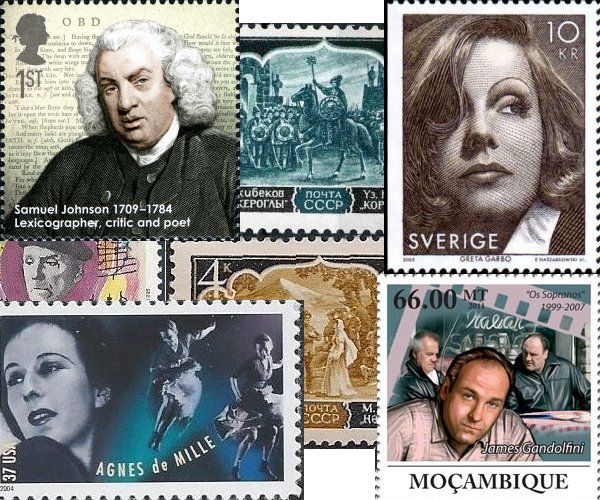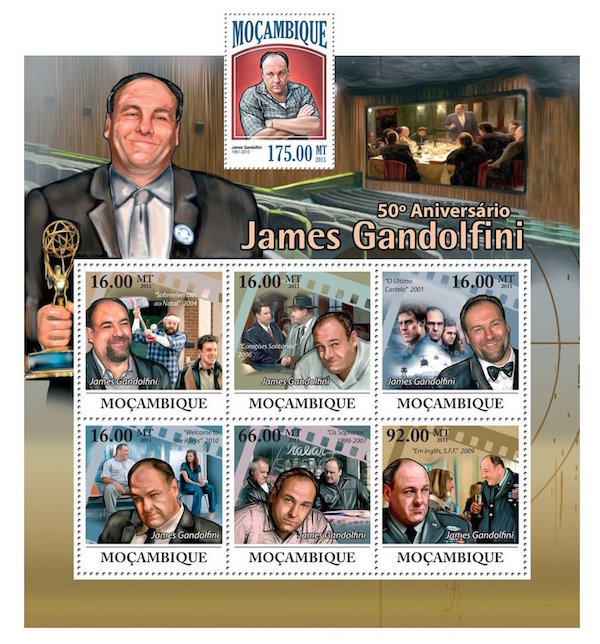The Arts on Stamps of the World — September 18
An Arts Fuse regular feature: the arts on stamps of the world.

By Doug Briscoe
Dr. Samuel Johnson’s biographer James Boswell relates a heartfelt anecdote that has remained with me for many years. A friend had painted a portrait of the great poet and lexicographer, who, let’s face it, was a rather unprepossessing man. Another friend, Topham Beauclerk, owned the painting and had an inscription from Horace added: “Ingenium ingens / Inculto latet hoc sub corpore.” (“Beneath that uncouth exterior are hidden vast gifts of mind.”) Let Boswell take up the tale: “After Mr. Beauclerk’s death, when it became Mr. [Bennet] Langton’s property, he made the inscription be defaced. Johnson said complacently, ‘It was kind in you to take it off;’ and then, after a short pause, added, ‘and not unkind in him to put it on.’” Today is the 318th anniversary of the birth of the magnificent Samuel Johnson (18 September 1709 [O.S. 7 September] – 13 December 1784). Though he wrote beautiful poetry (” The Vanity of Human Wishes”, 1749) and a memorable novella (The History of Rasselas, Prince of Abissinia, 1759), and biography (Lives of the Most Eminent English Poets, 1779-81), and brilliant essays for The Rambler and The Idler, and so much more, his most astonishing achievement is probably A Dictionary of the English Language (1755), which he prepared virtually single-handedly (it took him seven years, which seems short) and for which he oversaw several revisions.
We’ve had occasion here to see a number of joint international issues, those with essentially the same design on stamps of two different countries released on the same day. The 2005 Greta Garbo stamp is one such, except that the Swedish version was paired with another stamp showing her caricature in profile. Another Swedish issue shows a young Garbo in a still from her first feature, The Saga of Gösta Berling (1924). (Prior to that she had appeared only in a few filmed advertisements and a comedy short.) The two other Garbo stamps are from Germany and Senegal. After Gösta Berling and a German film directed by G. W. Pabst, Garbo was brought to America by Gösta director Mauritz Stiller. Her screen test made a lightning bolt impression, and her career was launched. She still spoke no English, but in the silents that didn’t much matter. It was 1930 before “Garbo talk[ed]!” Born Greta Lovisa Gustafsson on 18 September 1905, she retired from film at the age of 36 and lived to the age of 84, passing away on 15 April 1990. And now let us leave her, as I understand she wishes to be alone.
American dancer and choreographer Agnes de Mille (1905 – October 7, 1993) is our third Big Name for today. She was born in New York City. Cecil B. DeMille was her uncle (he never directed Garbo), and she provided the choreography for his great silent version of Cleopatra (1934, with Claudette Colbert, whose birthday was last week). Among Agnes de Mille’s more famous later projects were Aaron Copland’s Rodeo (1942), the film version of Oklahoma! (1943), stage versions of Carousel (1945) and Brigadoon (1947), and Morton Gould’s ballet Fall River Legend (1948).

Like Agnes de Mille, Dutch painter Anton Mauve (18 September 1838 – 5 February 1888) had a famous relative, in his case his cousin by marriage Vincent van Gogh. At the time, however, it was Mauve who was the bigger celebrity and, indeed, van Gogh’s strongly admired teacher. Mauve broke off the relationship, though, when he learned the younger artist was having an affair with a prostitute. Van Gogh did not reciprocate the ill feeling and even dedicated a painting, Souvenir de Mauve, to his mentor’s memory. Mauve himself was of the realist school, even to the point of including some discretely dabbed horse poop in his Morning Ride on the Beach (1876), which is shown on the stamp from Togo. The image resolution is poor, so follow the link to breathe in the atmosphere. (The Dutch portrait stamp is from 1939.)
September 18 happens to be the birthday of two Azerbaijani musicians who were born in the same year (1885) and worked together, Uzeyir Hajibeyov (u-zay-EER hah-dgi-BAY-of) and Muslim Magomayev (mah-ga-MAH-yef). Uzeyir bey Abdul Huseyn oglu Hajibeyov (1885 – November 23, 1948) is held to be the father of Azerbaijani classical music; he composed what is recognized as the first opera in the Islamic world, Leyli and Majnun (1908), based on a 15th century poem. (There are seven operas and three musical comedies altogether.) He also wrote the national anthem of the Azerbaijan Democratic Republic, still used today in independent Azerbaijan. His numerous other accomplishments include acting as editor-in-chief for the newspaper Azerbaijan (1919-20); the establishment in 1920 of the Baku Academy of Music, now named for him; the founding in 1931 of the Azeri Folk Instruments Orchestra, for which he transcribed Western music by such composers as Mozart, Schubert, and Bizet; writing the book The Basis of Folk Music in Azerbaijan in 1945; and serving twice as a deputy of the Supreme Soviet of the Soviet Union! In addition, he collaborated with his colleague Muslim Magomayev (see next paragraph) in collecting, transcribing, and publishing 300 pieces of Azeri folk music in their Collection of Azerbaijani Folk Songs (1927). The Soviet postal card (1966) and stamp and the two Azerbaijani stamps indicate the high regard in which Hajibeyov is held. The more recent (and more colorful) Azerbaijani stamp shows a scene from the composer’s operetta Arshin Mal Alan (The Cloth Peddler) of 1913. The Russian postal card was issued in 1966, and in the same year the USSR issued a pair of stamps (juxtaposed at left) honoring stage works by both Hajibeyov (Korogli or The Blind Man’s Son, written 1936, premièred 1937) and Magomayev (Nargiz of 1935).

Muslim Mahammad oglu Magomayev (1885 – 28 July 1937) got his own postal card in 1982, but to the best of my knowledge he is not yet represented on an Azerbaijani stamp. He was born, as I said above, on exactly the same day as Hajibeyov, although in less auspicious circumstances, his father having been a blacksmith (as opposed to Hajibeyov’s father, who was for many years secretary to the poet Khurshidbanu Natavan). At Gori Pedagogical Seminary the two students met and became friends, and there Magomayev developed his love for music. Initially he focused on teaching, but later took up music and conducting once again. In 1916, he wrote his first opera, Shah Ismayil, a work in the international (i.e., European) style. But it was Magomayev’s second opera, Nargiz, that became his best known work. Other than these scores, his output is limited to only a very small number of works, mostly orchestral rhapsodies. His grandson and namesake was an operatic baritone and pop singer known as the “Soviet Sinatra”.
Croatian composer Ivo Tijardović (EE-vo tee-YAR-do-vitch; 1895 – March 19, 1976) was also a writer and painter and a resistance fighter during World War II. He was the mayor of the city of Split during the Italian occupation while secretly leading its resistance organization set up by Tito. In 1942 he left the city and joined the partisans in the countryside. In his younger days he had been a conductor and stage designer as well as director of the Croatian National Theater and State Symphony Orchestra. His compositions are mainly for the stage: eight operettas and a musical, all from the 1920s and 30s, and three operas written in the 50s.

The father of Berlin-born Australian photographer Wolfgang Sievers (18 September 1913 – 7 August 2007) had been an art and architectural historian, dismissed from his post by Nazi authorities in 1933. Young Wolfgang had taken photos of buildings as his father’s assistant and would go on to specialize in architectural and industrial photography (the stamp is an exemplar of the latter) throughout his career. When conscripted into the Luftwaffe as an aerial photographer, Sievers immediately left the country, seeking his brother, who already lived in England. Wolfgang, though, went on to Australia, served with that nation’s army during the war, and opened a studio. He assisted in the hunt for escaped war criminals and lived to be just shy of 94.
“Tony Soprano”, James Gandolfini (September 18, 1961 – June 19, 2013) would have been 56 today had he not succumbed to a heart attack in Rome four years ago. The African nation of Mozambique has paid tribute to the late actor with a few stamp issues, including one of six stamps portraying him in different roles.
And a happy birthday to Metropolitan Opera star Anna Netrebko (born 18 September 1971)!
A graduate of the University of Massachusetts with a B.A. in English, Doug Briscoe worked in Boston classical music radio, at WCRB, WGBH, and WBUR, for about 25 years, beginning in 1977. He has the curious distinction of having succeeded Robert J. Lurtsema twice, first as host of WGBH’s weekday morning classical music program in 1993, then as host of the weekend program when Robert J.’s health failed in 2000. Doug also wrote liner notes for several of the late Gunther Schuller’s GM Recordings releases as well as program notes for the Boston Classical Orchestra. For the past few years he’s been posting a Facebook “blog” of classical music on stamps of the world, which has now been expanded to encompass all the arts for The Arts Fuse.

